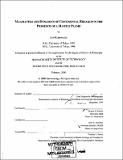Magmatism and dynamics of continental breakup in the presence of a mantle plume
Author(s)
Korenaga, Jun, 1970-
DownloadFull printable version (58.74Mb)
Other Contributors
Woods Hole Oceanographic Institution.
Advisor
Thomas H. Jordan and Peter B. Kelemen.
Terms of use
Metadata
Show full item recordAbstract
This thesis studies the dynamics of mantle melting during continental breakups by geophysical, geochemical, and numerical analyses. The first part focuses on the mantle melting and crustal accretion processes during the formation of the Southeast Greenland margin, on the basis of deep-crustal seismic data. A new seismic tomographic method is developed to jointly invert refraction and reflection travel times for a compressional velocity structure, and a long-wavelength structure with strong lateral heterogeneity is successfully recovered, including 30- to 15-km-thick igneous crust within a 150-km-wide continent-ocean transition zone. A nonlinear Monte Carlo analysis is also conducted to establish the absolute uncertainty of model parameters. The derived crustal structure is first used to resolve the origin of a margin gravity high, with new inversion schemes using both seismic and gravity constraints. Density anomalies producing the gravity high seem to be confined within the upper crust, not in the lower crust as suggested for other volcanic margins. A new robust framework is then developed for the petrological interpretation of the velocity structure of igneous crust, and the thick igneous crust formed at the continentocean transition zone is suggested to have resulted from vigorous active upwelling of mantle with only somewhat elevated potential temperature. In the second part, the nature of mantle melting during the formation of the North Atlantic igneous province is studied on the basis of the major element chemistry of erupted lavas. A new fractionation correction scheme based on the Ni concentrations of mantle olivine is used to estimate primary melt compositions, which suggest that this province is characterized by a large degree of major element source heterogeneity. In the third part, the nature of preexisting sublithospheric convection is investigated by a series of finite element analyses, because the strength of such convection is important to define the "normal" state of mantle, the understanding of which is essential to identify any anomalous behavior of mantle such as a mantle plume. The results suggest that small-scale convection is likely in normal asthenosphere, and that the upwelling velocity in such convection is on the order of 1- 10 cm/yr.
Description
Thesis (Ph. D.)--Joint Program in Oceanography (Massachusetts Institute of Technology, Dept. of Earth, Atmospheric, and Planetary Sciences; and the Woods Hole Oceanographic Institution), February 2000. Includes bibliographical references (p. 255-270).
Date issued
2000Department
Joint Program in Oceanography; Woods Hole Oceanographic Institution; Massachusetts Institute of Technology. Department of Ocean EngineeringPublisher
Massachusetts Institute of Technology
Keywords
Joint Program in Oceanography., Earth, Atmospheric, and Planetary Sciences., Woods Hole Oceanographic Institution.